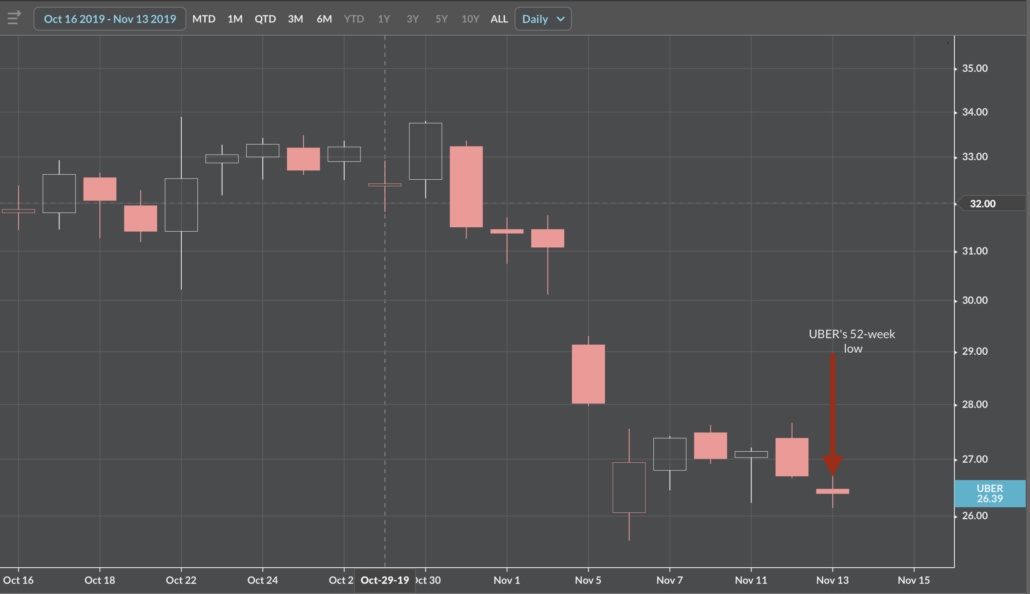Why Uber Stock Might Weather An Economic Downturn

Table of Contents
Economic downturns often send shockwaves through the stock market, causing widespread investor anxiety. However, some companies demonstrate surprising resilience, even thriving amidst challenging economic climates. This article explores why Uber stock, despite its reliance on discretionary spending in its ride-sharing segment, might be better positioned to weather an economic downturn than initially perceived. We'll analyze several key factors contributing to Uber's potential strength in a challenging economic climate, examining its diversification strategy, cost-cutting measures, and the essential nature of some of its services.
Uber's Diversified Revenue Streams
Uber's success isn't solely reliant on its ride-sharing services. The company has strategically diversified its revenue streams, creating a more robust and resilient business model. This diversification mitigates the risk associated with economic downturns, offering a buffer against decreased demand in any single sector.
Beyond Ridesharing: A Multi-faceted Business
Uber's expansion beyond its initial ride-hailing service is a significant factor in its potential resilience. The company's portfolio now includes:
-
Uber Eats: A dominant player in the food delivery market, Uber Eats offers a relatively recession-resistant revenue stream. Demand for food delivery often remains consistent, even during economic downturns, as consumers opt for cost-effective alternatives to restaurant dining. In fact, Uber Eats has shown impressive growth even during periods of economic uncertainty, showcasing its strength as a separate revenue driver.
-
Uber Freight: This segment focuses on connecting shippers with carriers, offering a crucial service within the logistics industry. While sensitive to overall economic activity, the demand for freight transportation remains relatively stable, even during recessions. Essential goods still need to be transported, ensuring some level of consistent revenue.
-
Other Services: Uber continues to explore and invest in other mobility and delivery solutions, further broadening its revenue base and mitigating risk. These new avenues present opportunities for growth and diversification, making Uber less vulnerable to the fluctuations impacting a single sector.
The diversification strategy significantly reduces reliance on a single revenue source. Each segment exhibits different levels of demand elasticity, meaning they react differently to economic shifts. This creates a more balanced portfolio, lessening the overall impact of economic downturns on Uber's financial performance. Recent financial reports highlight the significant contributions of Uber Eats and Uber Freight, further supporting the effectiveness of this diversification.
Geographic Diversification: A Global Reach
Uber's global presence is another critical aspect of its resilience. Operating in numerous countries across diverse economic landscapes allows the company to offset weakness in one region with strength in another.
-
Key Markets: Uber's presence in both developed and emerging markets provides a diversified revenue base, buffering against regional economic shocks. Strong performance in one region can compensate for slower growth in another.
-
Emerging Markets: The growth potential in emerging markets is significant. These regions often experience higher growth rates than developed economies, offering opportunities to compensate for any potential downturn in more mature markets. Uber's expansion in these areas presents a key element of long-term growth and resilience.
-
Regional Variations: By understanding and adapting to the unique economic conditions of each market, Uber can optimize pricing and operations for maximum profitability, further strengthening its position in times of economic uncertainty.
Cost-Cutting Measures and Operational Efficiency
Uber's commitment to operational efficiency and cost-cutting is another contributing factor to its potential resilience during economic downturns. The company continuously implements strategies to maximize profitability and minimize expenses.
Dynamic Pricing and Algorithmic Optimization
Uber leverages technology to enhance operational efficiency and maintain profitability. Dynamic pricing, for example, adjusts fares based on real-time demand. This allows Uber to maintain revenue even during periods of reduced demand, mitigating the impact of economic fluctuations.
-
Demand-Based Pricing: Dynamic pricing ensures that the company remains profitable even during periods of lower demand. By adjusting prices according to real-time supply and demand, Uber balances revenue and rider availability.
-
Optimized Driver Allocation: Uber's sophisticated algorithms optimize driver allocation, ensuring efficient utilization of resources and minimizing unnecessary costs.
-
Route Optimization: Advanced route planning and navigation systems minimize travel time and fuel consumption, further enhancing operational efficiency and reducing costs.
Focus on Profitability: A Long-Term Strategy
Uber has actively pursued initiatives to improve its profitability and financial health, making it better equipped to withstand economic shocks. This includes a significant focus on controlling operational costs and streamlining business processes.
-
Cost Reduction Strategies: Uber has implemented various cost-cutting measures throughout its operations, from optimizing its workforce to negotiating better deals with suppliers.
-
Operational Restructuring: Changes in operational structure have been implemented to enhance efficiency and profitability, further strengthening the company's financial resilience.
-
Long-Term Financial Health: Uber’s commitment to long-term financial health provides a strong foundation to navigate periods of economic uncertainty.
Essential Service Nature (Resilience during Recessions)
Beyond its diversified revenue and efficient operations, Uber's services are increasingly viewed as essential, offering resilience during economic hardship.
Ride-sharing as a Necessity
Ride-sharing services like Uber can become increasingly crucial during economic downturns, particularly for individuals without personal vehicles or reliable public transport. The ability to access flexible and affordable transportation becomes vital for those needing to commute to work, access healthcare, or handle emergencies.
-
Essential Transportation: Uber provides essential transportation for many, particularly in areas with limited public transportation options.
-
Accessibility: Uber's accessibility during economic hardship can become even more critical for individuals and families facing transportation challenges.
-
Supporting Data: Studies showcasing the reliance of certain populations on ride-sharing services during economic downturns could further strengthen this argument.
Uber Eats as a Reliable Food Source
During economic downturns, many people cut back on dining out, opting for more cost-effective meal solutions. Uber Eats provides a convenient and relatively affordable alternative, potentially driving increased demand.
-
Cost-Effectiveness: Uber Eats can be cheaper than restaurant dining, especially when considering factors like delivery fees and tips.
-
Convenience: The convenience of food delivery is a major draw, particularly during uncertain economic times.
-
Increased Demand: Economic downturns can lead to an increase in demand for food delivery services like Uber Eats, providing a reliable revenue stream.
Conclusion
Uber's potential to weather an economic downturn rests on several key factors: its diversified revenue streams, its dedication to operational efficiency and cost-cutting measures, and the increasing perception of its services as essential in various aspects of daily life. The company's strategic expansion beyond ride-sharing, its global reach, and its focus on profitability place it in a comparatively strong position compared to companies reliant on single revenue streams or less adaptable business models.
While no investment is without risk, understanding the factors that contribute to Uber's potential resilience is crucial for investors considering its stock. Further research into Uber's financial performance and strategic initiatives, including its exploration of autonomous vehicles, will provide a more comprehensive view of its long-term prospects. Learn more about investing in Uber stock and its potential to navigate economic uncertainty.

Featured Posts
-
 Infografis Solusi Dua Negara Harapan Yang Menipis And Respons Indonesia
May 18, 2025
Infografis Solusi Dua Negara Harapan Yang Menipis And Respons Indonesia
May 18, 2025 -
 Pos I Ellada Mporei Na Ginei Koryfaio Naytiliako Kentro Pagkosmios
May 18, 2025
Pos I Ellada Mporei Na Ginei Koryfaio Naytiliako Kentro Pagkosmios
May 18, 2025 -
 Jackbit Review Top Bitcoin Casino With Instant Withdrawals
May 18, 2025
Jackbit Review Top Bitcoin Casino With Instant Withdrawals
May 18, 2025 -
 Batistas Exit Banco Master Asset Discussions A Jbs Jbss 3 Update
May 18, 2025
Batistas Exit Banco Master Asset Discussions A Jbs Jbss 3 Update
May 18, 2025 -
 Hubungan Israel Vatikan Memanas 3 Faktor Yang Menyebabkan Boikot Pemakaman Paus Fransiskus
May 18, 2025
Hubungan Israel Vatikan Memanas 3 Faktor Yang Menyebabkan Boikot Pemakaman Paus Fransiskus
May 18, 2025
